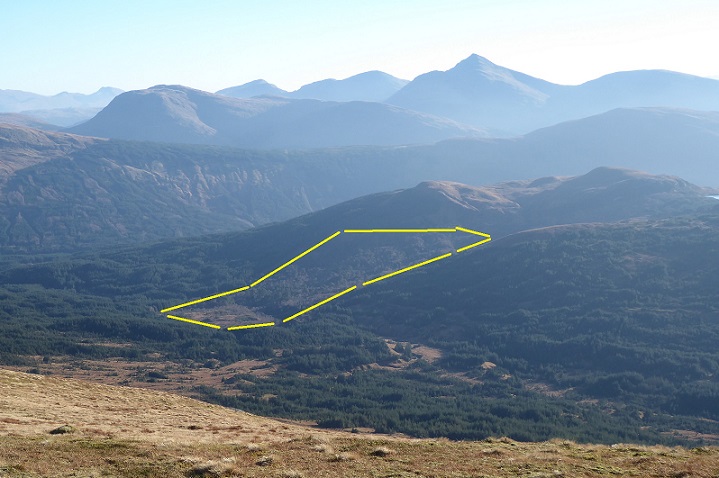
Last week I visited the Allt Broighleachan Caledonian Pinewood Reserve on the north side of Glen Orchy (and outside the Loch Lomond and Trossachs National Park) on my way to Glen Coe. It was my second visit, inspired in part by the Caledonian Pinewood Conference which took place last Autumn and which I viewed online because I went down with Covid just before. A video of the conference is available (see here) – I particularly recommend the presentation from James Rainey, ecologist from Trees for Life (whose presentation starts at 2.18.40).
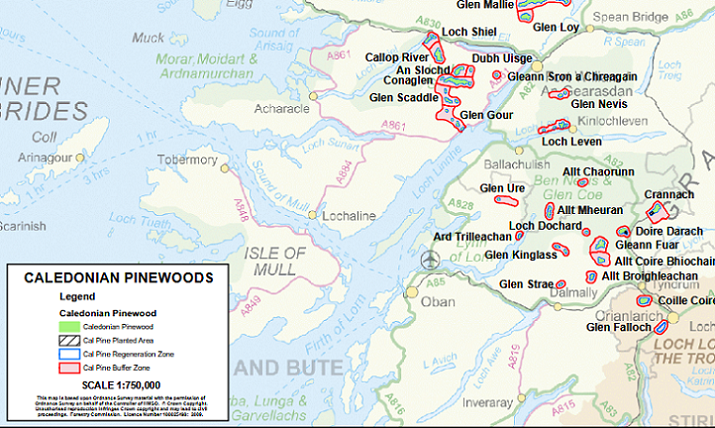
The focus of the conference was on the Caledonian pinewoods in Western Scotland, which tend to be less well known, smaller and more fragmented than those in the Cairngorms and are generally in a poor state. This is primarily a result of overgrazing by red deer and invasive non-native conifers but it appears climate change is also impacting on the speed and ability of Scots Pine in the west to regenerate.
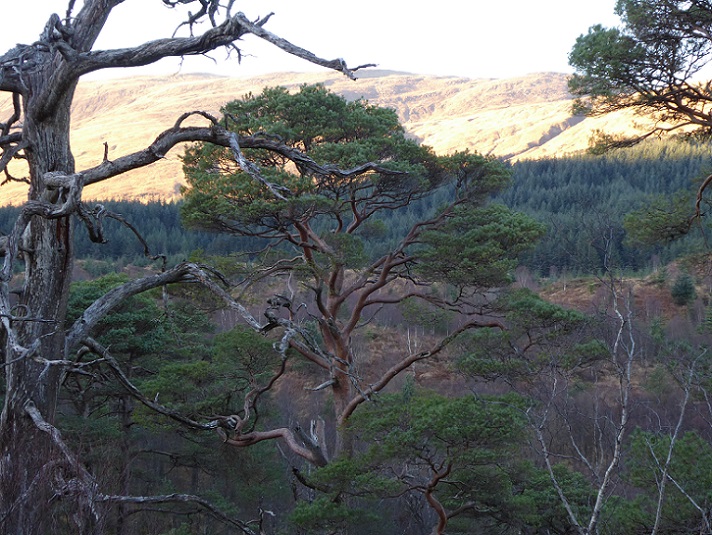
It is something of a miracle that any Caledonian Pine Forest survives in Glen Orchy. The statistical account for the parish of Innishail and Glen Orchy in 1792 records: “The highest parts of the parish abounded once with forests of the largest and the best firs, but these were cut down about sixty years ago by a company of adventurers from Ireland…………… This sealed the fate of those noble forests”.
The timber from the extensive woods in Glen Orchy was floated to Loch Awe and then out through the Pass of Brander to the west. This was a consequence of events that took place far away. A law passed in England had forbidden the importation of live cattle from Ireland. This led to a surge in demand for wood there to construct barrels for salting beef and for leather tanning. Since Ireland by this time was almost completely deforested, the Irish were forced to source their wood abroad and in 1722 two Irish merchant adventurers signed a contract for selective exploitation of the timber in this area with the second earl of Breadalbane. The earl was lax in monitoring the contract, which would have been a challenge in any case because of the extent of his lands, and in the three years he was not looking the merchants felled almost all the trees leaving remnants at Allt Broighleachan and Allt Coire Bhiocair.
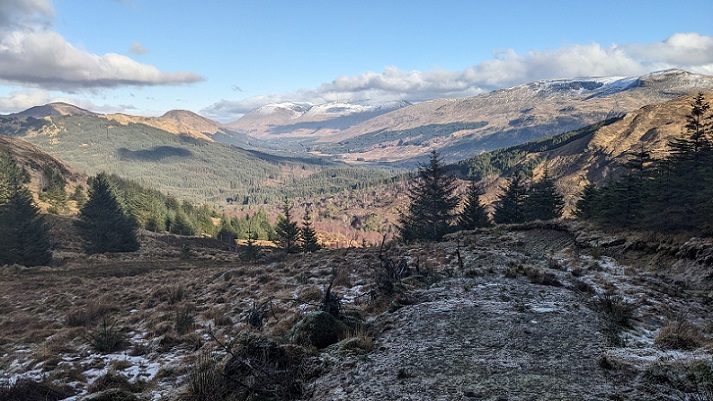
The Forestry Commission acquired most of the land in Glen Orchy in the 1950s and 1960s before ploughing and planting it, surrounding the two areas of native pine wood. The vast majority of the Glen Orchy “forest” is now made up of sitka, with the exception of the pinewood remnants. There is also a strip of land along the River Orchy which was retained by the previous owners and is lined with naturally regenerated native broadleaved trees.
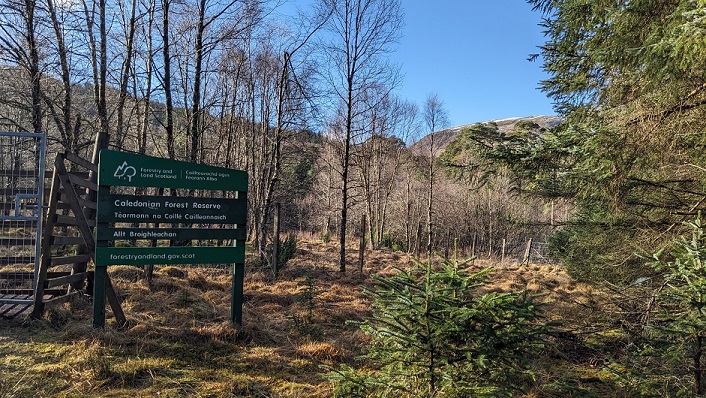
The former Forestry Commission established the Allt Broighleachain Pinewood as a Caledonian Forest Reserve in 1977 and it was designated as a Site of Special Scientific Interest in 1986. According to NatureScot’s Site Management Statement on “Sitelink” (see here) the initial “focus of management was on the restoration of the diversity in age grouping and woodland structure within the site boundary of the site. However, in 1994 there was a change in emphasis and the site was viewed as a refuge from which pinewood habitat and species could colonise adjacent ground by way of regeneration and by group plantings of pine of local provenance”.
Moreover, “regeneration within the 1988 exclosures was poor and a more extensive exclosure was constructed. This involved the felling to waste of existing commercial plantations in Coire Thoraidh and Luib nan Coileach to create ground on which regeneration could occur. In addition, intensive culling within the CFR dramatically reduced deer numbers.”
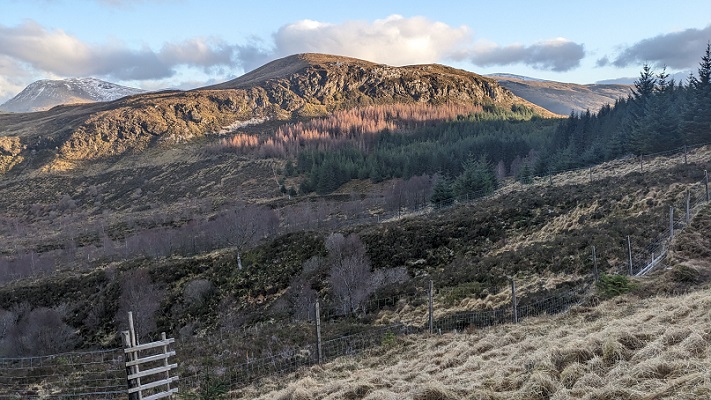
The site management statement continues:
“In 1998, an Endangered Habitat Action Plan was agreed between SNH and Forest Enterprise for the long-term management of the CFR [Caledonian Forest Reserve] , and adjacent ground. …………The initial 5-year objective was to promote regeneration within the core pinewood and regeneration areas. The 20-year objective is to extend regeneration within the CFR into areas above the existing fence in Coire Thoraidh and extend the reserve to the east into the Allt Broighleachan gorge. The 100-year objective is to increase the pinewood regeneration to 250 hectares [the original reserve and SSSI was 40 ha] and extend regeneration towards the Allt Coire Bhiocair pinewoods, 4 km to the north”. (my underlining). Admirable!
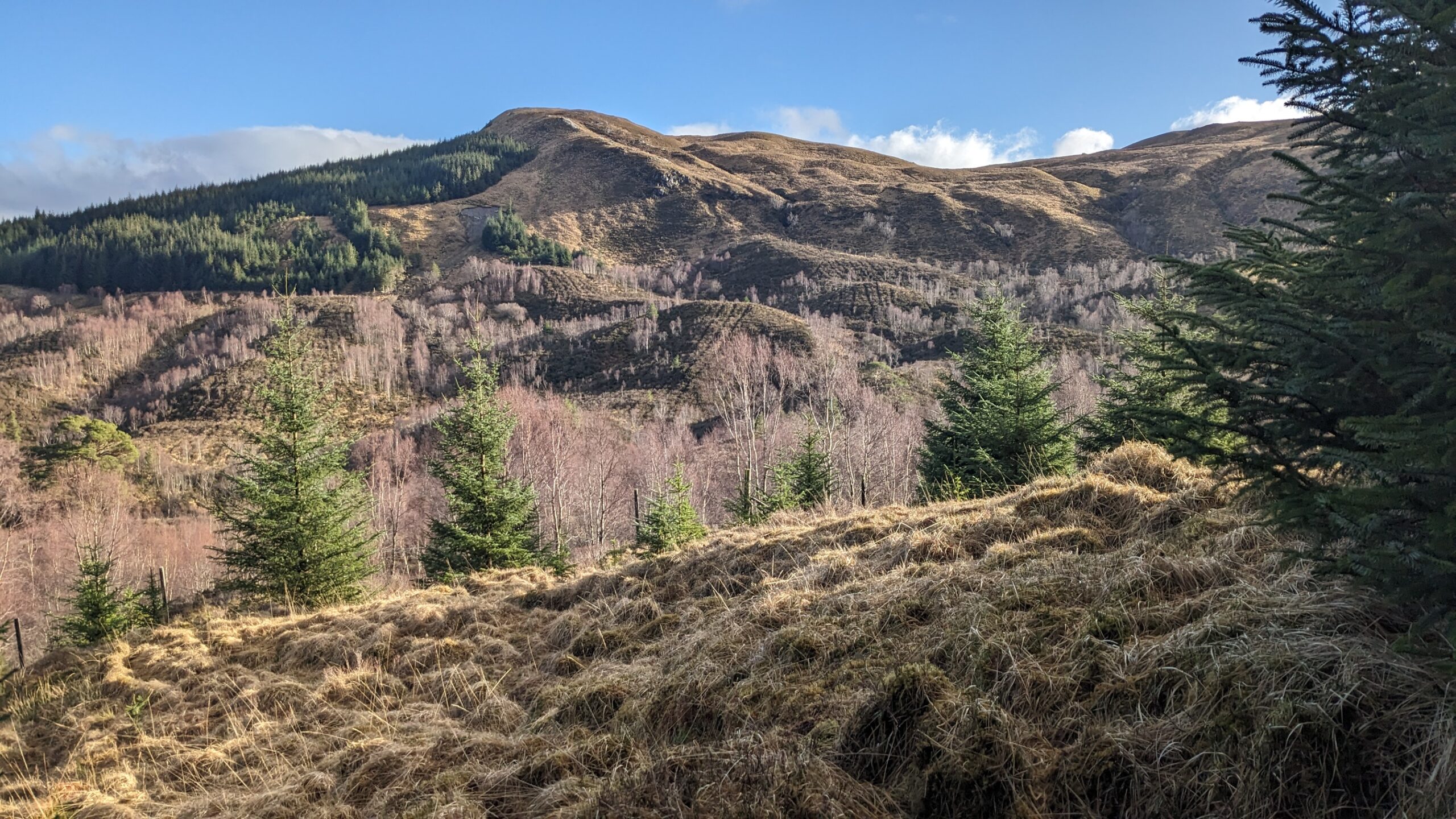
This objective was more ambitious than the guidelines adopted by the Forestry Commission in 2003 in ‘The Management of Semi-natural Woodlands. 7 Native pinewoods” which set out the rationale for the management and expansion of Caledonian pinewoods. They recommended that “natural regeneration is strongly preferred” for expansion and that “planting should be the last resort”. There were to be two zones for expansion around the ‘core’ areas of Caledonian pinewood: a ‘regeneration
zone’ of 100m, and a ‘buffer zone’ of 500m beyond the regeneration zone. It also recommended “Exotic conifers, sometimes underplanted or planted within the regeneration zone in the past, should be removed as soon as is practical.”
Fast forward to Forest and Land Scotland’s Glen Orchy Glen Lochy Land Management Plan (LMP) (see here) which was approved on 8th January 2024 and runs for 10 years.

How much progress, if any, had been made on the 1998 plan is not stated but helps confirm my interpretation of what I saw on the ground, very little appears to have been achieved in the last 25 years.
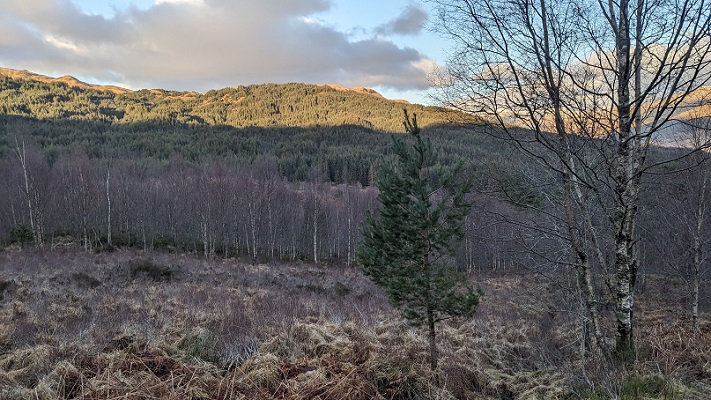
The main evidence I saw for natural regeneration within the reserve was of trees which, judging by their size, seeded about the same time, perhaps 15 years ago. There was very little evidence of any regeneration after that until far more recently:
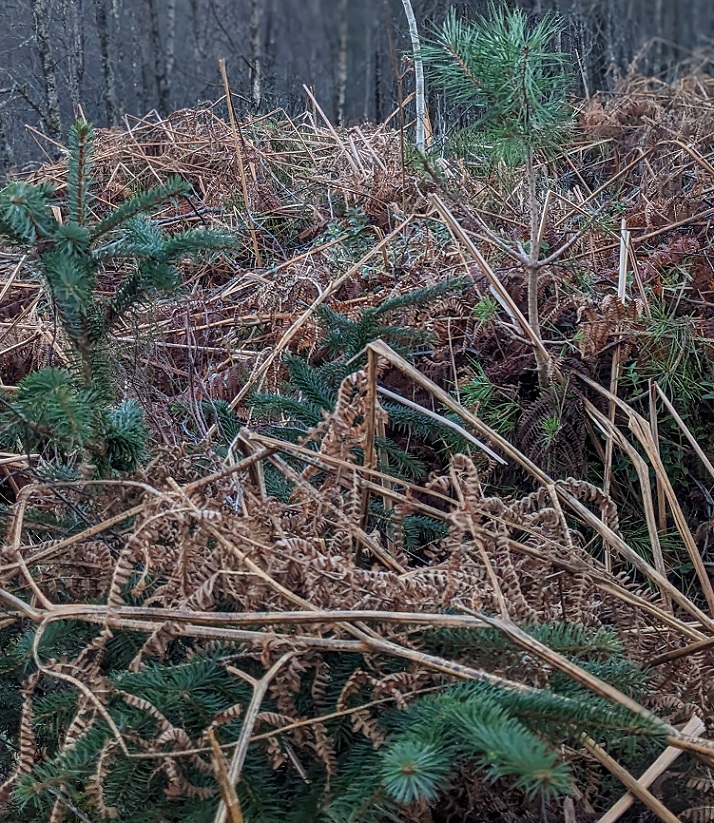
There were a few young Scots Pine saplings, evidence of recent regeneration, but many more sitka spruce saplings. The source of this problem is quite obvious, all the older sitka planted right up to the deer fence
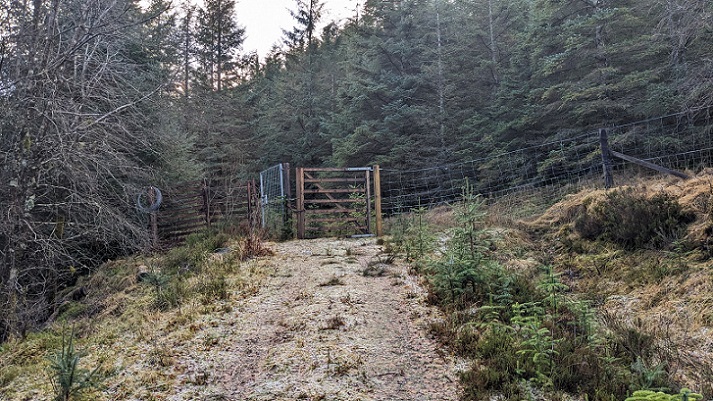
There was also some “adolescent” Scots Pine, which also all appeared of a similar age:
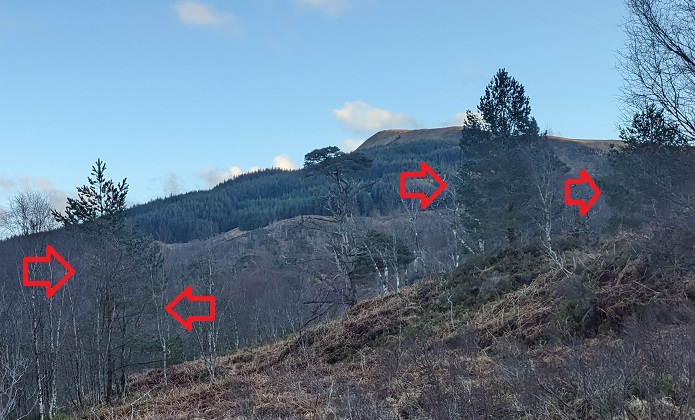
These Scots Pine possibly date from conservation efforts 30-40 years ago when the reserve was first fenced.
This evidence suggests that the Allt Broighleachan pinewood has only been regenerating naturally in three relatively short periods over the last 46 years. If correct, the implication is that in the intervening and longer periods deer have got in through the fences and prevented regeneration taking place. That is consistent with the statement in FLS’ new LMP that restoration has stalled.
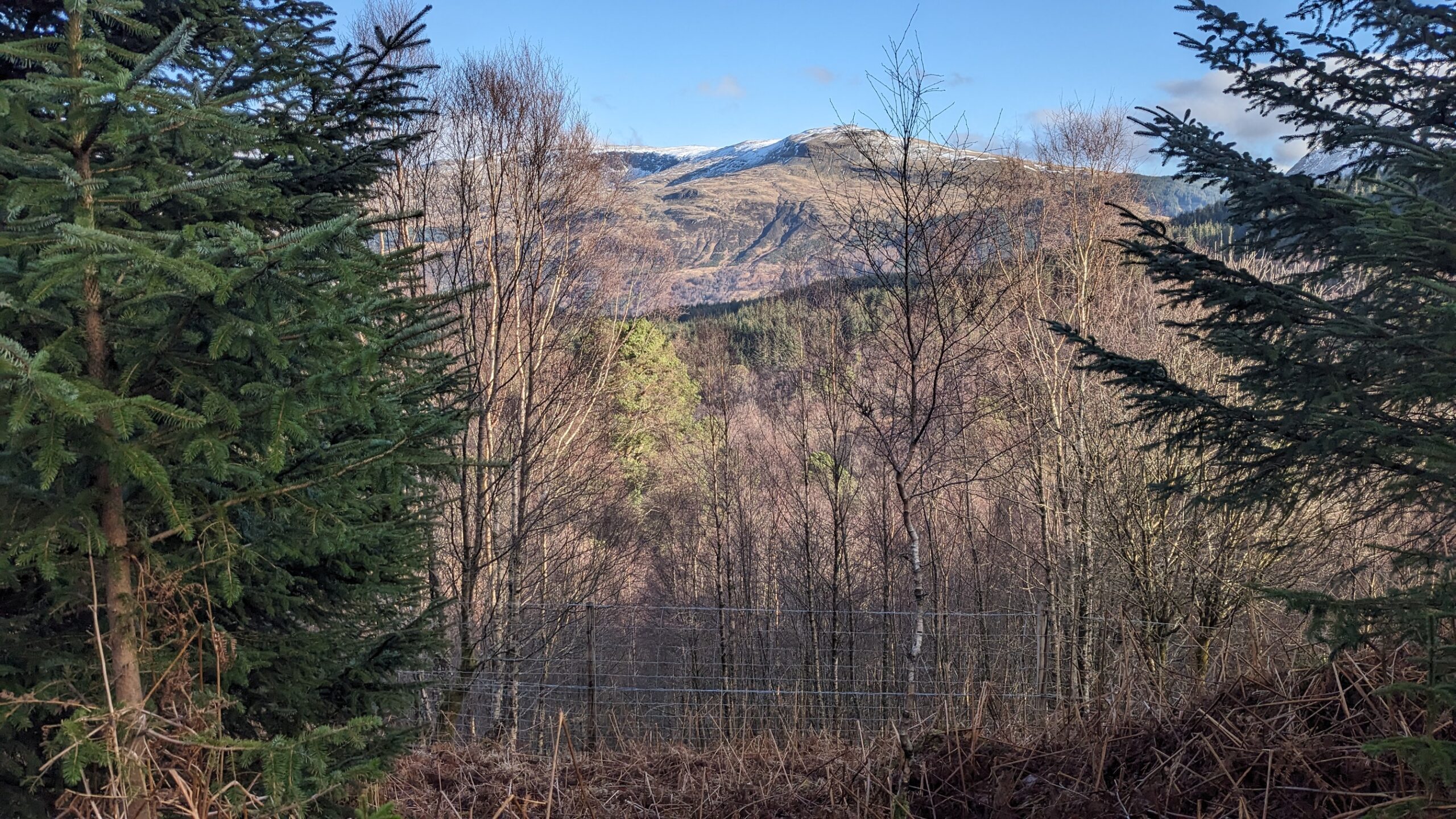
As for the aspiration for the Caledonian Pinewood to expand beyond the fences, which was consistent with the 2003 guidelines on regeneration and buffer zones, that has gone nowhere.

This map from the LMP shows that almost all the buffer zone and part of the regeneration zone is planted with non-native conifers, predominantly sitka. While there is an argument that FLS should not harvest the sitka until they are ready to use, they don’t appear to have made any attempt to fell the self-seeded sitka around the plantation and it is spreading out onto the hillside above creating a new problem.
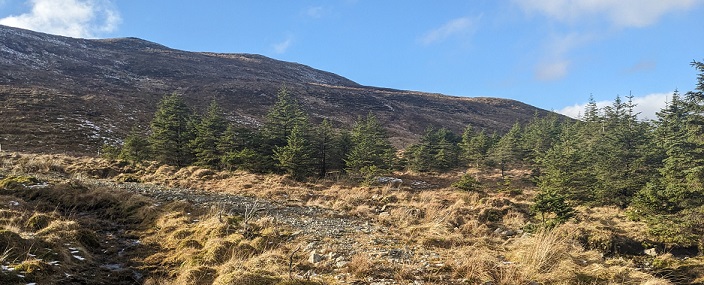
Despite this evidence of what is happening in the core area and in the regeneration and buffer zones NatureScot in 2021 judged that the SSSI was in favourable condition and faced no negative pressures:

That judgement is in my view is completely wrong. Unfortunately NatureScot do not publish the evidence they use to reach their conclusions and one wonders whether any of their staff even visit the site? By chance an expert, Ron Summers, formerly a Principal Conservation Scientist at RSPB and author of a great book on Abernethy, surveyed 78 out of the 84 woods listed in the Caledonian Pinewood Inventory in 2021 (“The effect of planted trees and self-seeding non-native conifers on the expansion and integrity of Caledonian pinewoods” Scottish Forestry 77 No 3 Autumn/Winter 2023). I checked what he found at Allt Broighleachan when I got home and he, like me, recorded self-seeded sitka in the core zone and non-native plantation in the buffer zone.
Ron’s study found “at least 34 sites (40%) had non-native trees (seedlings, saplings and/or old
trees) and shrubs that had self-seeded into or within core areas” and that “the probability of finding non-native conifers in core areas was greater in sites managed or part-managed by FLS”.
Despite the obvious threat to the site from “sitka rain” NatureScot’s site management statement which was last updated in 2008 does not even refer to the need to remove non-native species but instead requires FLS to “(1.2) Monitor regeneration of exotic species within cleared sections”. It is no wonder so many of the remaining fragments of Caledonian Pinewood in Scotland are in such a poor state.
FLS’s new LMP does propose removing much of the non-native conifer plantation which surrounds Allt Broighleachan and which has been adversely affecting it since it was declared a Caledonian Pinewood Reserve.
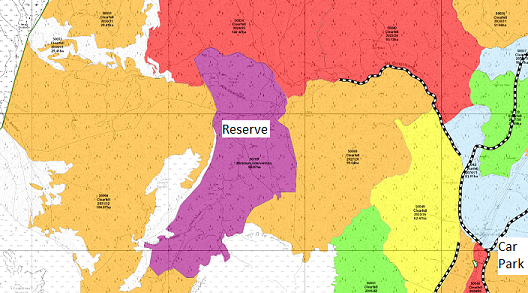
On the plus side FLS is not proposing to re-stock these areas with non-native conifers:
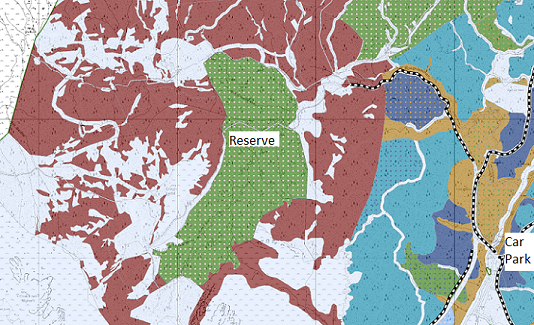
The total area for natural regeneration in Glen Orchy, however, is only 34 ha. That is far less than the 210 ha of natural regeneration agreed for Allt Broighleachan in the 1998 Endangered Habitat Plan. The vast majority of the brown area will be planted with native broadleaves which FLS claim will “protect and enhance the pinewoods”.
Unfortunately, planting broadleaves will not prevent self-seeded sitka from getting established and shading out the broadleaves and there is nothing in the LMP about how FLS will deal with this problem. Moreover, unless FLS try to restore all the ploughlines (visible in the photos above) any planting will likely have to follow the raised lines above the drainage ditches replicating the existing plantation but with native species.
Time for a rethink about how to restore Scotland’s native pinewoods
The Caledonian Pinewood Conference last year was prompted in large part because, after half a century of management which was supposed to put conservation first, many are in a little better state and some in a worse state than they were before. Allt Broighleachan exemplifies many of the issues. The pinewood restoration that has been taking place at Mar Lodge, Glen Feshie and the other estates in Cairngorms Connect, which involves reducing deer numbers and removing non-native conifers, is the exception not the rule.
While at the time, in 2003, the introduction by the Forestry Commission of regeneration and buffer zones appeared to be a positive step forward, in many places, as Allt Broighleachain and Ron Summer’s research shows, they have been totally ineffective. This is in part because the Forestry Commission and other commercial forestry interests had already planted non-native conifers in and around the pinewoods and the failure to reduce deer numbers.
But it is also because the guidelines have been widely ignored by our public authorities: for example the guideline that “exotic conifers” should be “removed as soon as is practical” has been ignored at Allt Broighleachain while the guideline that “planting should be the last resort” has been ignored by the Loch Lomond and Trossachs National Park Authority at Glen Falloch (see here). Basically our public authorities, NatureScot, Scottish Forestry and our two National Parks have not been interested in using their powers to ensure pinewood restoration happens but instead left it up to individual landowners to decide what to do.
Rather than try and fix the problems with regeneration and buffer zones, a number of activists believe it is time to be far more ambitious and create “expansion zones” around all the pinewoods listed on the Caledonian Pinewood Inventory which comprise a tiny area compared to that which is planted with sitka. Des Thompson, former Principal Adviser on Biodiversity at NatureScot, presented some of these ideas at the end of the pinewood conference (also recommended viewing).
The basic concept is that the Caledonian expansion zones should cover all the ground in the catchment where a pinewood fragment is located and this demarcated on a map. The presumption against planting would be extended to the whole of this area and instead of FLS planting trees or Scottish Forestry paying landowners to do so through the Forestry Grant system resources would be redirected to weed out non-native conifers and reduce deer numbers. That would enable a significant proportion of the small isolated pockets of Caledonian pinewood in the West to join up and landscape scale, instead of pocket sized, conservation.
The forthcoming Natural Environment (Scotland) Bill provides an opportunity for the Scottish Parliament to put such a vision for nature restoration into effect. Meantime Scottish Ministers should ensure FLS’ has the resources to enable nature restoration across it’s whole estate. Otherwise the public should conclude the acquisition of Glen Prosen in the Cairngorms (see here) was nothing more that a vanity project designed to deceive us that the Scottish Government and FLS’ were committed to restoring nature

In practical terms, restoring pinewoods in the west is an order of magnitude more difficult than in the east, for the reasons that you mention, but also because the (usually) ,more fertile soils combined with higher rainfall creates vegetation and ground conditions which are very difficult for Scots Pine seed to penetrate, and there tend to be more slugs and fungal diseases in the more humid climate there that creates higher mortality in seedlings, even if the other problems were not present. I think that to progress, we need to differentiate west & south type pinewood sites from the much easier to regenerate eastern sites. Talk honestly about the problems and additional costs, and we might then get somewhere.
Recently FLS held an exhibition in our village (Drymen, in LLTNP) to consult local people about their proposals for a small but locally important fragment of the Queen Elizabeth Forest above the village.
The chance to speak directly to FLS staff was very revealing. They informed us that FLS receives no public money; any work they would like to carry out has to be funded by income from timber sales. In addition, the principle focus from ‘on high’ is on maximising income from timber production. Habitat management, creation and enhancement come very far down the pecking order, and staff concerned with this aspect of forest management are chronically under resourced, financially and physically. Storms like Eowyn, which cause a colossal amount of damage in the forests, sets their work programmes back significantly and leaves them struggling to catch up.
The staff I spoke to were very much on board with the benefits of deer culling and natural regeneration; they knew their trees and described the best case scenario of leaving ground fallow for 5 years to allow Sitka seed to germinate before removing the seedlings and allowing natural regen to occur. SItka seed is only viable for 5 years. But they’re up against the ‘big picture’ assumption of broadleaved planting and deer fencing.
And no wonder Caledonian pines are struggling; a Scots pine tree doesn’t reach maturity and start producing seed until it’s around 100 years old.
One of the big problems here is that there are not enough foresters on the ground who see this problem and care enough about it to challenge Head Office. Forestry and Land Scotland has become a profit maximising enterprise and its new head is an Accountant. Deer control pays for itself if properly managed but that would mean upsetting the sporting estates, which this particular government is not prepared to do. We have all these agencies who are meant to be protecting and managing our natural heritage but the top people seem to be in thrall to vested interests who only want profit for themselves. It is too bad we don’t have a thriving community woodland sector that could manage these sites on our behalf for nature.
Disagree with this Douglas. That FLS woodland area will be big enough to have a self sustaining internal deer population. It is not a case of deer coming in from the outside. Sometimes, the public sector has to accept its own responsibility, and not just assume some-one else is to blame. The deer density in that woodland will be much higher than the hill outside.
Hi Victor, it is true that the Glen Orchy forests are large enough to have their own deer population but why has FLS just put up a new fence around the forest if its not to stop deer from Blackmount coming in? My understanding is FLS cull large numbers of deer, so perhaps the fences are to avoid upsetting sporting estates by shooting “their” deer? Where I suspect we agree is that until there is a statutory requirement for all landowners to report on deer culls and until all the information is published in real time we really won’t know who is doing their bit and who not.
My experience is that people see the deer threat to be on the outside, but often under-estimate the deer within. All properties already have a statutory duty to report deer culls, and all relevant interests and Nature Scot will have access to that information through deer groups. The people who dont get access are of course activists, who may get 50% of the picture. It is difficult to make cull info publicly available without making stalkers vulnerable to animal rights activists and the like, and public sector and NGO stalkers are probably more likely to be targeted than others, often by their own members. Once in their sights, you will never escape. Plenty of evidence of keepers being targeted, and making their lives a misery. WE dont want to exacerbate that. Information in the wrong hands can be damgerous, and we must not be naive about that.
Hi Victor, I appreciate its very difficult to count/know how many deer there are in forests except when there is snow on the ground. I was surprised the week after new year when I twice walked through the plantation on the Inverinate estate taking two different routes that despite the two gates on the upper side being open and despite the deer clear struggling to find food on the hill there were no tracks on the forest road (I saw one set of tracks from a roe deer). It would appear that despite the paltry amount of food available on the open hill it was better than the sitka plantation. Deer of course do eat younger sitka and other species of trees so other types of woodland will be different but the majority of the FLS estate is sitka.
I don’t follow your logic that publicising numbers of deer/deer culled could make stalkers vulnerable to animal rights activists. If someone is so against culling deer that they would be prepared to harass a stalker they would surely do so whatever number of deer are culled? I would be really interested therefore in seeing the evidence that shows keepers lives are being made a misery and why this is? (I write this as someone who has been a vegan for 40 years but, if I was hungry enough, choose wild venison before any other meat – I think there is increasing recognition about people who care about animal rights that high numbers of deer can only be maintained at the expense of other animals). Nick
Nick… speak to the SGA about what some of their members have to put up with. Or let them write a piece on the subject for you. We have to live in the real world.
I know what members of the SGA have published about raptor conservationists and others. So I won’t be relying on anything they write or say. I live in the real world. I believe what I see and believe people who I trust.